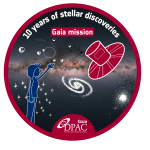Ten years of stellar discoveries: the Gaia mission
On December 19, we are celebrating the 10th anniversary of the launch of the ESA Gaia satellite.
 The Gaia satellite started its mission ten years ago after its launch on December 19, 2013. Its goal is to repeatedly measure with an unprecedented accuracy the position and motion of Solar System objects and of more than 1 billion stars as well as to classify these. Various versions of the Gaia catalogue, increasingly improving, were published. The 4th data release is now in sight and is foreseen in 2025, and the 5th and final catalogue is expected for 2030. In ten years, Gaia initiated a true revolution in astronomy and in our knowledge of the structure, dynamics and evolution of the Milky Way as well as of our Solar System.
The Gaia satellite started its mission ten years ago after its launch on December 19, 2013. Its goal is to repeatedly measure with an unprecedented accuracy the position and motion of Solar System objects and of more than 1 billion stars as well as to classify these. Various versions of the Gaia catalogue, increasingly improving, were published. The 4th data release is now in sight and is foreseen in 2025, and the 5th and final catalogue is expected for 2030. In ten years, Gaia initiated a true revolution in astronomy and in our knowledge of the structure, dynamics and evolution of the Milky Way as well as of our Solar System.
At the Astronomy and Astrophysics department of the Royal observatory of Belgium, and with the support of Belspo, five researchers are involved in the preparation and development of the Gaia mission since 2006, when the Gaia Data Processing and Analysis Consortium (DPAC) was officially started. They are working hard for the next Gaia data releases.
Follow the Gaia revolution on ESA’s dedicated webpages (https://www.cosmos.esa.int/web/gaia/image-of-the-week) or even take part to it (https://www.zooniverse.org/projects/gaia-zooniverse/gaia-vari/about/research).
